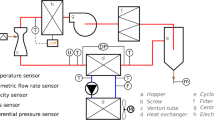Abstract
The time dependent performance of extended surfaces subjected to fouling is addressed in this work. Where fins are used for augmenting boiling heat transfer, the interaction of local values of temperature excess, fouling resistance and surface characteristics of the deposit can be quite complex. Taking typical asymptotic fouling growth parameters from literature for reverse solubility salts, three kinds of fin geometry are analysed – rectangular, triangular and annular. For various values of the fin parameter mL, the temperature distribution and variation of fouling resistance are obtained as a function of time. To interpret the performance of a fouled fin, a new term `cleanliness efficiency' is introduced. The necessity of choosing an optimal value of mL for the fin is also highlighted here. It is shown that for all three fin configurations, cleanliness efficiency differs little, thus simplifying the geometry dependence. The approach set out in this work will help in the design of finned heat exchangers subjected to fouling and thereby minimise their overdesign.
Similar content being viewed by others
Author information
Authors and Affiliations
Additional information
Received on 12 July 2000
Rights and permissions
About this article
Cite this article
Aparajith, H., Balaji, C. & Raghavan, V. Performance analysis of extended surfaces subjected to fouling. Heat and Mass Transfer 37, 499–505 (2001). https://doi.org/10.1007/s002310100214
Issue Date:
DOI: https://doi.org/10.1007/s002310100214




